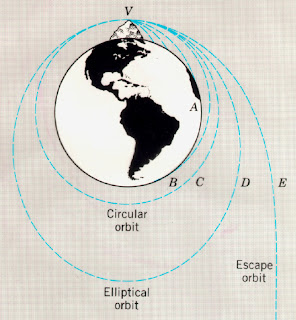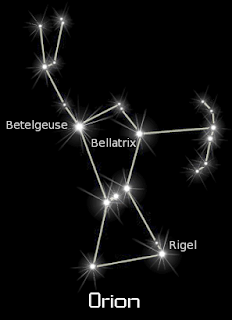Stars
Learning Goals: Understand that stars come in different types.
Success Criteria: You can describe the life cycle of different stars.
Stars come in many different sizes, colours and temperatures. Here are a few ways we can tell the difference between stars.
Luminosity
- Total amount of energy produced by a star per second.
- The sun has luminosity of 1.
Apparent Magnitude
- A star's brightness as seen from Earth.
- The sun = -27 apparent magnitude
- Full Moon = -13
- Brightest Stars = 1
- dimmest stars = 6
Absolute Magnitude
- The magnitude we would see if we were 33 ly away.
Colour
- A star's colour is related to temperature.
- Blue - hotter
- Yellow - medium
- Red - cooler
Spectrum
- The rainbow of light emitted by a star.
- Missing lines in the spectrum tell you what the star is made of.
 |
| Each element emits a different spectrum. The missing colours (dark bands) line up with hydrogen, so the star definitely has hydrogen in it. |
Mass
- The sun is 2 e 30 kg = 1 solar mass
- Most stars range from 0.1 to 120 solar masses.
The life cycle of stars
Nebula - a massive cloud of gas and dust.
Protostar - dust from a nebula collapses under gravity.
After millions of years, a protostar collapses further until fusion happens, 15 million °C.
The type of star depends on mass.
Hertzsprung-Russell Diagram
- hot, luminous stars are more massive.
- most stars fall on "Main Sequence"
Small stars:
After 10 billion years, burn off hydrogen and expand to become red giants.
hydrogen --> helium --> other elements (lithium, carbon, etc)
Eventually stops fusion and a white dwarf is left over. Cool down and fade out.
Bigger Stars:
Shorter lives, burn faster.
Can fuse heavier elements
carbon --> iron
After fusion, gases collapse, then bounce back and explode into a super nova.
 |
| The Crab Nebula is the left over from a super nova. |
Heavier elements are fused.
After super nova you can have one of two things left over...
Neutron Star - made of pure neutrons.
Super dense, gravity 300 000 times that of earth.
 |
| This is what Neutron Star would look like over Vancouver. Much smaller than the Earth, but hundreds of thousands of times more massive. |
Black hole - even more dense than neutron stars, gravity so strong that light cannot escape.
 |
| An artists drawing of a star being torn apart by a black hole. |
 |
| The life cycle of different stars. |
Homework
- P. 351 # 1, 2, 6, 7, 9
- P. 369 # 1-3, 6, 7, 8, 11































.gif)










